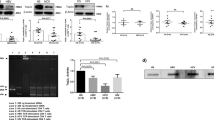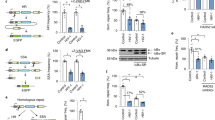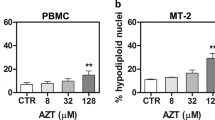Abstract
Tat is an early regulatory protein of human immunodeficiency virus type 1, which plays a central role in the pathogenesis of AIDS by stimulating transcription of the viral genome and impairing several important cellular pathways during the progression of the disease. Here, we investigated the effect of Tat on cell response to DNA damage. Our results indicate that Tat production causes a noticeable increase in the survival rate of PC12 cells upon their treatment with genotoxic agents. Single-cell gel electrophoresis studies revealed reduced DNA breakage in PC12-Tat cells upon cisplatin treatment relative to the control cells. Furthermore, cytogenetic data exhibited less chromosomal damage in Tat-producing cells after recovery from cisplatin treatment, corroborating electrophoretic data. Examination of several proteins involved in the control of DNA repair showed elevated levels of Rad51, a key regulator of homologous recombination in cells expressing Tat. On the other hand, the level of Ku70, one of the components of the nonhomologous end-joining repair pathway, was slightly decreased in cells expressing Tat. Using a fluorescence-based assay, we demonstrated that repair of DNA double-strand breaks via homologous recombination is increased in Tat-producing cells. The results from in vitro nonhomologous end-joining assay revealed a reduced ability of protein extract from PC12-Tat cells compared to PC12 cells in rejoining linearized DNA. These observations ascribe a new role for Tat in host genomic integrity, perhaps by affecting the expression of genes involved in DNA repair.
This is a preview of subscription content, access via your institution
Access options
Subscribe to this journal
Receive 50 print issues and online access
$259.00 per year
only $5.18 per issue
Buy this article
- Purchase on Springer Link
- Instant access to full article PDF
Prices may be subject to local taxes which are calculated during checkout




Similar content being viewed by others
References
Aguilera A . (2001). Trends Genet., 17, 318–321.
Barboric M, Nissen RM, Kanazawa S, Jabrane-Ferrat N and Peterlin BM . (2001). Mol. Cell, 8, 327–337.
Baumann P and West SC . (1998). Proc. Natl. Acad. Sci. USA, 24, 14066–14070.
Bennasser Y, Badou A, Tkaczuk J and Bahraoui E . (2002). Virology, 303, 174–180.
Berkhout B, Verhoef K, Marzio G, Klaver B, Vink M, Zhou X and Das AT . (2002). J. Neurovirol., 8 (Suppl 2), 134–137.
Brown KD, Rathi A, Kamath R, Beardsley DI, Zhan Q, Mannino JL and Baskaran R . (2003). Nat. Genet., 33, 80–84.
Buonaguro L, Barillari G, Chang HK, Bohan CA, Kao V, Morgan R, Gallo RC and Ensoli B . (1992). J. Virol., 66, 7159–7167.
Chen P, Mayne M, Power C and Nath A . (1997). J. Biol. Chem., 272, 22385–22388.
Clark E, Santiago F, Deng L, Chong S, de La Fuente C, Wang L, Fu P, Stein D, Denny T, Lanka V, Mozafari F, Okamoto T and Kashanchi F . (2000). J. Virol., 74, 5040–5052.
Douek DC, Picker LJ and Koup RA . (2003). Ann. Rev. Immunol., 21, 265–304.
Duan L, Ozaki I, Oakes JW, Taylor JP, Khalili K and Pomerantz RJ . (1994). J. Virol., 68, 4302–4313.
Esposito G, Ligresti A, Izzo AA, Bisogno T, Ruvo M, Di Rosa M, Di Marzo V and Iuvone T . (2002). J. Biol. Chem., 277, 50348–50354.
Featherstone C and Jackson SP . (1999). Mutat. Res., 434, 3–15.
Gonzalez E, Punzon C, Gonzalez M and Fresno M . (2001). J. Immunol., 166, 4560–4569.
Green MH, Lowe JE, Waugh AP, Aldridge KE, Cole J and Arlett CF . (1994). Mutant Res., 316, 91–102.
Kai M and Wang TS . (2003). Genes Dev., 17, 64–76.
Kashanchi F, Agbottah ET, Pise-Masison CA, Mahieux R, Duvall J, Kumar A and Brady JN . (2000). J. Virol., 74, 652–660.
Kundu M, Sharma S, De Luca A, Giordano A, Rappaport J, Khalili K and Amini S . (1998). J. Biol. Chem., 273, 8130–8136.
Lambotte O, Deiva K and Tardieu M . (2003). Brain Pathol., 13, 95–103.
Lee SH and Kim CH . (2002). Mol. Cell, 13, 159–166.
Li CJ, Wang C, Friedman DJ and Pardee A . (1995). Proc. Natl. Acad. Sci. USA, 92, 5461–5464.
Liang C and Wainberg MA . (2002). AIDS Rev., 4, 41–49.
Magnusson KP, Sandstrom M, Stahlberg M, Larsson M, Flygare J, Hellgren D, Wiman KG and Ljungquist S . (2000). Gene, 246, 247–254.
Mahieux R, Lambert PF, Agbottah E, Halanski MA, Deng L, Kashanchi F and Brady JN . (2001). J. Virol., 75, 1736–1743.
McCloskey TW, Ott M, Tribble E, Khan SA, Teichberg S, Paul MO, Pahwa S, Verdin E and Chirmule N . (1997). J. Immunol., 158, 1014–1019.
Persaud D, Zhou Y, Siliciano JM and Siliciano RF . (2003). J. Virol., 77, 1659–1665.
Peruzzi F, Gordon J, Darbinian N and Amini S . (2002). J. Neurovirol., 8 (Suppl 2), 91–96.
Phimister EG . (2003). N. Engl. J. Med., 348, 643–644.
Pierce AJ, Johnson RD, Thompson LH and Jasin M . (1999). Genes Dev., 15, 2633–2638.
Rappaport J, Joseph J, Croul S, Alexander G, Del Valle L, Amini S and Khalili K . (1999). J. Leukoc. Biol., 65, 458–465.
Rautonen N, Rautonen J, Martin NL and Wara DW . (1994). AIDS, 8, 1504–1506.
Reynolds L, Ullman C, Moore M, Isalan M, West MJ, Clapham P, Klug A and Choo Y . (2003). Proc. Natl. Acad. Sci. USA, 100, 1615–1620.
Sawaya BE, Khalili K, Gordon J, Taube R and Amini S . (2000). J. Biol. Chem., 275, 35209–35214.
Sawaya BE, Thatikunta P, Denisova L, Brady J, Khalili K and Amini S . (1998). J. Neuroimmunol., 87, 33–42.
Sengupta S, Linke SP, Pedeux R, Yang Q, Farnsworth J, Garfield SH, Valerie K, Shay JW, Ellis NA, Wasylyk B and Harris CC . (2003). EMBO J., 22, 1210–1222.
Shi B, Raina J, Lorenzo A, Busciglio J and Gabuzda D . (1998). J. Neurovirol., 4, 281–290.
Singh NP, Stephens RE and Schneider EL . (1994). Int. J. Radiat. Biol., 66, 23–28.
Venkitaraman AR . (2002). Cell, 108, 171–182.
Acknowledgements
We thank the past and present members of the Center for Neurovirology and Cancer Biology for their insightful discussion, and sharing of reagents and ideas. We also thank C Schriver for editorial assistance and preparation of this manuscript. This work was made possible by grants awarded by NIH to KK, BS, and SA. TS is a scholar of the Leukemia and Lymphoma Society.
Author information
Authors and Affiliations
Corresponding author
Rights and permissions
About this article
Cite this article
Chipitsyna, G., Slonina, D., Siddiqui, K. et al. HIV-1 Tat increases cell survival in response to cisplatin by stimulating Rad51 gene expression. Oncogene 23, 2664–2671 (2004). https://doi.org/10.1038/sj.onc.1207417
Received:
Revised:
Accepted:
Published:
Issue Date:
DOI: https://doi.org/10.1038/sj.onc.1207417
Keywords
This article is cited by
-
Functional roles of HIV-1 Tat protein in the nucleus
Cellular and Molecular Life Sciences (2016)
-
DNA repair mechanisms and human cytomegalovirus (HCMV) infection
Folia Microbiologica (2015)
-
HIV-1 Tat and AIDS-associated cancer: targeting the cellular anti-cancer barrier?
Journal of Experimental & Clinical Cancer Research (2008)
-
HIV-1 Tat targets Tip60 to impair the apoptotic cell response to genotoxic stresses
The EMBO Journal (2005)
-
Molecular mechanisms of action and prediction of response to oxaliplatin in colorectal cancer cells
British Journal of Cancer (2004)



